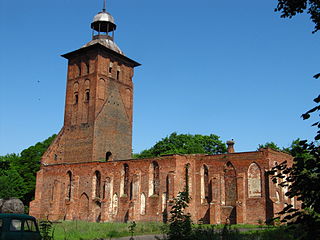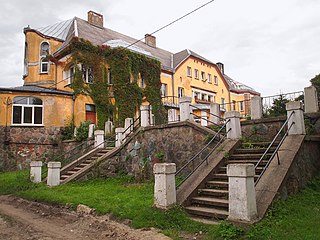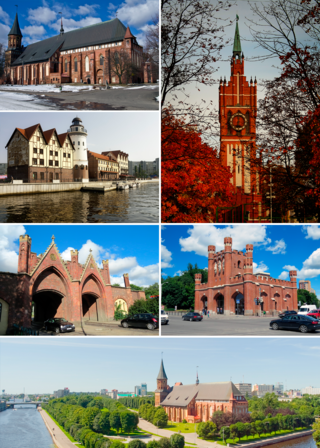
The cultural heritage of Kaliningrad Oblast is a mixture of the pre-World War II German, Lithuanian and Polish heritage, dating back to the Ducal Prussian and East Prussian periods, and the Soviet and Russian designs constructed since then.

The cultural heritage of Kaliningrad Oblast is a mixture of the pre-World War II German, Lithuanian and Polish heritage, dating back to the Ducal Prussian and East Prussian periods, and the Soviet and Russian designs constructed since then.
Many heritage sites in Kaliningrad Oblast were damaged during World War II, or willfully destroyed in the postwar period by Soviet authorities. [1] A number of landmarks did survive, such as the gothic Königsberg Cathedral containing the tomb of Kant, or the Königsberg Stock Exchange building. [2] Already in the 1960s, a group of local architects and intellectuals began to campaign for the preservation of the region's German heritage, albeit unsuccessfully. [3]
The first Soviet housing blocks were built only in 1966. [4] The spread of Soviet-style prefabricated panel buildings eventually changed the appearance of Kaliningrad. The 1970s House of Soviets is another part of the local Soviet architectural period. [2]
Mirroring the rediscovery of pre-revolutionary history in the rest of Russia, since 1991 there have been many efforts to recover the prewar heritage sites of Kaliningrad. [1] Preservation and reconstruction efforts are hampered by a complicated property ownership situation, as during the 1990s the city administration raised cash by selling land for construction without regard for central planning. [5]
Old buildings are being restored, and new ones built in conscious imitation of the old Königsberg architecture. [3] Some local architects are cautious about the reconstruction efforts, worried that the result may end up looking too kitsch and unauthentic. [5]
Königsberg Cathedral was successfully restored from 1992 to 1998, in a joint Russian-German project. [3] The Fischerdorf development, while being a new development, is a city quarter that intentionally mirrors the prewar architectural styles. [3] A project to restore Kant's House in Veselovka was announced in 2013, and should be completed in time for the 2018 World Cup. [6]
The ruins of Königsberg Castle are being excavated, with a plan to preserve them under a transparent enclosure. [7]

| | This section needs expansion. You can help by adding to it. (May 2024) |
The Lithuanian Church in Sovetsk, traditional capital of Lithuania Minor, [8] was destroyed by the Soviets in 1951–1952. Preserved Lithuanian heritage is mostly in the eastern part of the province, within the historic Lithuania Minor region. In Chistye Prudy, there is a Memorial Museum of Kristijonas Donelaitis, author of The Seasons , the first Lithuanian poem. Several churches, which hosted Lithuanian services for the region's Lithuanian population in the past, are located in the province, including the preserved churches in Slavsk and Saranskoe and ruins in Chernyshevskoye, Kalinino, Ozyorsk and Ulyanovo.

| | This section needs expansion. You can help by adding to it. (May 2024) |
The former Polish Church at Steindamm, the main Polish Church of Königsberg and the city's oldest church, where Jan Seklucjan, publisher of the oldest Polish translation of the New Testament, was a pastor in the mid-16th century, [9] was demolished by the Soviet administration in 1950. In 1972, the Soviets destroyed the main church of Chernyakhovsk, which also hosted Polish services in the past. The Königsberg Cathedral was historically also a place of worship for local Poles with Polish-language services held there until the 18th century. It contains the epitaph of 17th-century Polish princely magnate Bogusław Radziwiłł and his wife Anna Maria, renovated in 2007–2008 with funds from the Polish Ministry of Culture and National Heritage. [10]
In 2011, a Polish-built monument with Polish and Russian inscriptions was unveiled at the site of the former Hohenbruch concentration camp at Gromovo where Nazi Germany imprisoned mostly Poles, especially intelligentsia. [11]

Elbląg is a city in the Warmian-Masurian Voivodeship, in northern Poland, located in the eastern edge of the Żuławy region with 117,390 inhabitants, as of December 2021. It is the capital of Elbląg County.

Kaliningrad Oblast is the westernmost federal subject of the Russian Federation, in Central and Eastern Europe. It is a semi-exclave situated on the Baltic Sea. The oblast is surrounded by two European Union and NATO members: Poland to the south and Lithuania to the north and east. The largest city and administrative centre of the province (oblast) is the city of Kaliningrad, formerly known as Königsberg. The port city of Baltiysk is Russia's only port on the Baltic Sea that remains ice-free in winter. Kaliningrad Oblast had a population of roughly 1 million in the Russian Census of 2021.

Chernyakhovsk, known prior to 1946 by its German name of Insterburg, is a town in Kaliningrad Oblast, Russia, and the administrative center of Chernyakhovsky District. Located at the confluence of the Instruch and Angrapa rivers, which unite to become the Pregolya river below Chernyakhovsk, the town had a population in 2017 of 36,423.

East Prussia was a province of the Kingdom of Prussia from 1773 to 1829 and again from 1878 ; following World War I it formed part of the Weimar Republic's Free State of Prussia, until 1945. Its capital city was Königsberg. East Prussia was the main part of the region of Prussia along the southeastern Baltic Coast.

Gusev is a town and the administrative center of Gusevsky District of Kaliningrad Oblast, Russia, located at the confluence of the Pissa and Krasnaya Rivers, near the border with Poland and Lithuania, east of Chernyakhovsk. Population: 28,177 (2021 Census); 28,260 (2010 Russian census); 28,467 (2002 Census); 27,031 (1989 Soviet census).

Baltiysk is a seaport town and the administrative center of Baltiysky District in Kaliningrad Oblast, Russia, located on the northern part of the Vistula Spit, on the shore of the Strait of Baltiysk separating the Vistula Lagoon from Gdańsk Bay. Population: 33,946 (2021 Census); 32,697 (2010 Russian census); 33,252 (2002 Census); 27,070 (1989 Soviet census).

The Pregolya or Pregola is a river in the Russian Kaliningrad Oblast exclave.

Königsberg Cathedral is a Brick Gothic-style monument in Kaliningrad, Russia, located on Kneiphof island in the Pregolya river. It is the most significant preserved building of the former city of Königsberg, which was largely destroyed in World War II.

The University of Königsberg was the university of Königsberg in East Prussia. It was founded in 1544 as the world's second Protestant academy by Duke Albert of Prussia, and was commonly known as the Albertina.

Ordensburg is a German term meaning a "castle of a (military) order". It is used specifically for the fortified structures built by crusading German military orders during the Middle Ages.

Balga was a medieval castle of the Teutonic Knights in Kaliningrad Oblast, Russia. The castle ruins are located on the shore of the Vistula Lagoon, north of Mamonovo in the Pogranichny municipality of Bagrationovsky District, about 30 km (19 mi) southwest of Kaliningrad.

Znamensk is a rural locality in Gvardeysky District of Kaliningrad Oblast, Russia, located on the right bank of the Pregolya River at its confluence with the Lava River 50 kilometers (31 mi) east of Kaliningrad. Population figures: 4,036 (2010 Russian census); 4,302 (2002 Census); 4,570 (1989 Soviet census).

The Königsberg Castle was one of the landmarks of the East Prussian capital Königsberg, Germany.

Saranskoe, Saranskoye is a rural locality (selo) in Kaliningrad Oblast. It lies approximately 11 kilometres (7 mi) east of Polessk.

Königsberg is the historic German and Prussian name of the medieval city that is now Kaliningrad, Russia. The city was founded in 1255 on the site of the small Old Prussian settlement Twangste by the Teutonic Knights during the Baltic Crusades. It was named in honour of King Ottokar II of Bohemia, who led a campaign against the pagan Old Prussians, a Baltic tribe.

The Brandenburg Gate is one of seven surviving city gates in Kaliningrad, the former German city of Königsberg. The gate is located on Bagration Street and is the only gate of Kaliningrad still in use for the intended purpose.

Kaliningrad, until 1946 known as Königsberg, is the largest city and administrative centre of Kaliningrad Oblast, a Russian exclave between Lithuania and Poland. The city sits about 663 kilometres (412 mi) west of the bulk of Russia. The city is situated on the Pregolya River, at the head of the Vistula Lagoon on the Baltic Sea, and is the only ice-free Russian port on the Baltic Sea. Its population in 2020 was 489,359, with up to 800,000 residents in the urban agglomeration. Kaliningrad is the second-largest city in the Northwestern Federal District, after Saint Petersburg, the third-largest city in the Baltic region, and the seventh-largest city on the Baltic Sea.

The following is a timeline of the history of the city of Kaliningrad, Russia. The city was known as Königsberg prior to 1945 and Twangste prior to 1255.

The Kaliningrad question is a political question concerning the status of Kaliningrad Oblast as an exclave of Russia, and its isolation from the rest of the Baltic region following the 2004 enlargement of the European Union.
Krylovo is a rural locality in Pravdinsk Urban Okrug, Pravdinsky District, Kaliningrad Oblast, Russia, on the border with Poland. Population: 785 (2010 Russian census); 756 (2002 Census); 2,291 (1905).
{{cite book}}: CS1 maint: location missing publisher (link)